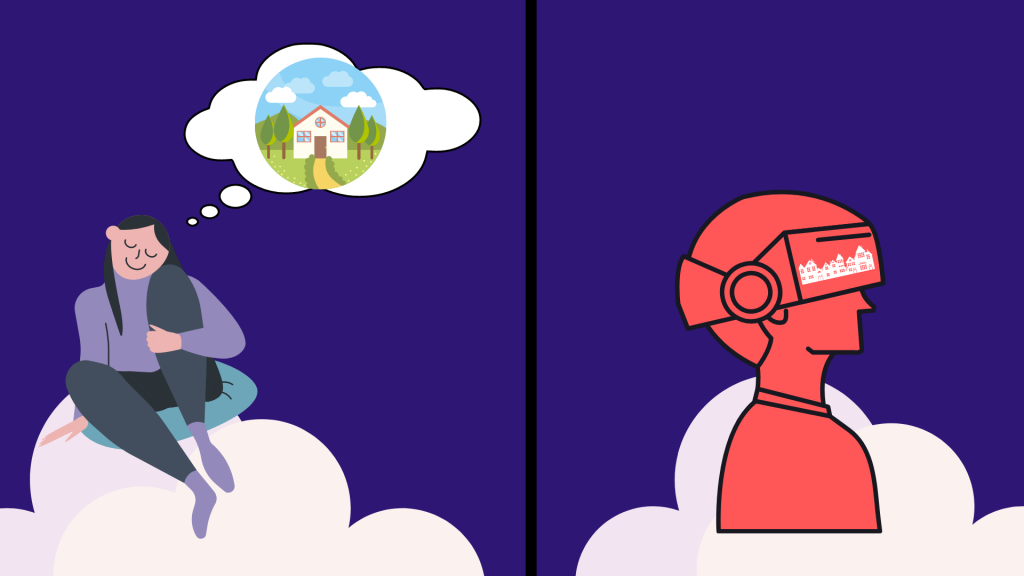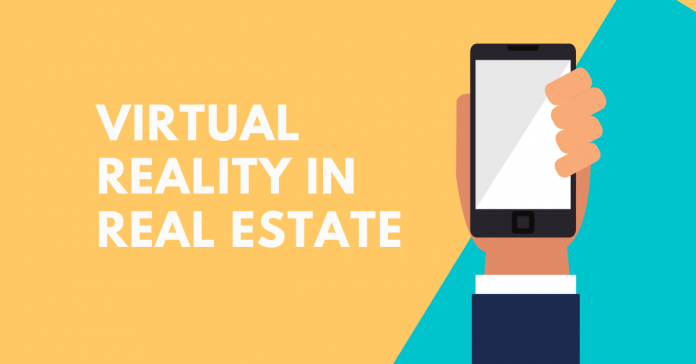From office complexes and apartments to retail outlets, purchasing a real estate asset is a time-consuming and hectic process. Buyers and real estate agents invest a lot of time and money in exploring properties or setting site visits before initiating the final agreement. However, with the advent of disruptive technologies like augmented and virtual reality, the real estate industry in India is galloping into new heights. We bring to you a blog that enumerates the significance of using virtual reality in real estate. We will also shed light on and the techniques through which you can implement the technology.
What is Virtual Reality?
You experience an altogether different world when you dream. And when you daydream (which all of us do) to detach yourself from your actual surroundings, you create your own little imaginary world. Plus, your senses such as vision, hearing, touching, and even smelling is stimulated during the process. So although you are dreaming, you experience something real.
This is what exactly is virtual reality.
The only difference between a dream and VR is that in the latter, an imaginary world is created through computer technology. And of course, you are not dreaming!

Now let us bifurcate the term Virtual Realty to understand its technical meaning.
“Virtual” means near or almost near, and “Reality” means the real world. Hence, virtual reality is a digitally created experience of the actual world. This digital simulation alters the real physical world to create an imaginary world. Unlike television where there is a screen in front of you, you will have to use a wearable gadget like headsets to experience the imaginary world.
How is VR Different from Augmented Reality?
The technology which alters the physical world by adding different elements to it is called augmented reality. Through AR, an imaginary world is not created. Rather, the real world is supplemented with immersive images and objects. Although both augmented and virtual reality tools are a part of disruptive technologies, there are some major differences between the two. Glance through the points tabulated below for a clear understanding.
| Virtual Reality | Augmented Reality |
| Creates an imaginary world | The real world is overlapped with imagery or other elements |
| Requires a handheld controller or a head-mounted device | Delivered on smartphones, tablets, laptops through apps |
| Users cannot add or change objects | Easy to add, delete or change elements |
| Examples include Oculus Rift, Volvo VR test drives | Examples include Pokemon Go, L’Oréal’s makeup testing app, Lenskart’s 3D-try on |
How to Use Virtual Reality in Real Estate?
From commercial real estate to residential complexes, virtual reality plays a significant role in the real estate sector. Let us look at a few ways in which you can implement virtual reality in real estate.
1. Guided Visits
As a general norm, homebuyers collate a list of properties they want to explore and visit the sites. While some homes are stationed nearby, others are located on the outskirts. Therefore, scheduling a visit and shortlisting an ideal home becomes physically and mentally taxing. Virtual reality in real estate solves all these problems effectively.
You can offer three-dimensional views of hundreds of properties with just a click and at the comfort of your home. Panoramic camera, 360-degree images, virtual reality headset–and Bam! You just allowed your client to take a virtual walkthrough of the chosen property!
2. Interactive Visits
Nowadays, interactive visits are also gaining impetus. The primary difference between guided and interactive visits is that in the latter, the homebuyer can click on the screen and take a closer look of the different corners of the house. However, in the case of guided visits, the client can talk a walkthrough of the property through a virtual reality headset. Although interactive visits can be expensive, they offer a holistic view of the property.
3. Virtual Staging
Put yourself in the shoes of a homebuyer and ask yourself a question. Would you prefer viewing pictures of fully furnished properties or that of an empty house? As a homebuyer, you would want to imagine how a property would look with furnishings. Therefore, it’s possible that you will stick with the former. But how do you offer such services to your clients? The answer is simple-Virtual Staging.
What is Virtual Staging?
Virtual staging is a process through which empty spaces are virtually furnished. Simply put, VS is a real estate digital marketing strategy that allows homebuyers to visualize themselves in fully furnished properties. From natural textures and wooden floorings to plush couches and indoor plants, you can catch a buyer’s interest by staging a home virtually. While this type of virtual reality for real estate has its set of advantages, a poorly executed staging can push viewers away and will do more harm than good. Hence, it is advised to consult VS specialists.
Advantages
If you are exploring ways on how to sell your property fast, then virtual staging is an effective tool. Summarized below are the key advantages of the virtual staging technology:
- In comparison to traditional home staging, it is more cost-effective.
- Does not give a cold and abandoned feeling
- Umpteen décor and furnishing choices
- You can redecorate properties
- Provides a simulation of depth, size, and height
4. Landlord-Tenant Communication
Nowadays, modern homes and ultra-luxurious apartments come with an array of utility services. While they offer comfort and convenience, using such tools or services can get confusing at times. This is another example of how implementing AR/VR in real estate can be fruitful.
By simply putting on headsets or by downloading specific apps, the tenants can understand how different tools or buttons work. For example, if a property owner is not sure how to change the temperature through a thermostat, the augmented reality mobile app can help the owner in understanding the working. Although this can be an expensive technique, it will be beneficial in the long run.
Advantages of Using Virtual Reality in Real Estate
Now that you have got an overview of what VR is all about, let us understand how implementing virtual reality in real estate will be beneficial for you, as a real estate agent.
- Time and Cost Friendly
Not only your clients, but you will also save a lot of time and money by implementing VR technology. This is because you won’t have to go house hunting everytime, commute expenses will be saved, and you won’t have to stage the property.
- Develops an Emotional Connect
Implementing virtual reality in real estate allows homebuyers to examine every nook and corner of the house. Unlike the traditional door to door method, viewing a home virtually is not a one time affair. A client can come back and check the details they missed out earlier, thereby developing a sense of ownership.
- Increase Profits
Not every realtor implements virtual reality for their real estate business. So, if you incorporate 3D-technology, it will give you a competitive edge over others. Your brand will gain impetus and your profits will increase!
- Easy Experimentation
One of the biggest advantages of using virtual reality in real estate is that it allows you to customize properties as per the user requirements. For example, if a customer wants to see plush and comfy beds with minimalistic textures, then you can modify the furnishing accordingly.
- Reach a Wider Pool of Audience
What’s better than showcasing your properties to people from across the country at the same time? By offering virtual property tours, you can focus on the other services which you offer and can interact with multiple clients at the same time.
The Power of Mixed Reality in Real Estate
In the world of real estate, the integration of VR and AR provides a ground-breaking field of engaging and interactive experiences. The process of visiting, investing, and experiencing the property market will be changed by the new reality that blends VR and AR. It enables users to engage with both virtual and actual components virtually at the same time, resulting in the most absorbable environment with the technologies of virtual reality and augmented reality.
Benefits of Mixed Reality in Real Estate
Mixed reality in housing brings multiple advantages. Mixed reality creates immersive 3D models of the properties and virtually overlays elements such as furniture, landscaping, and renovations. Potential buyers can imagine how this property would have looked if it had been staged or renovations were already done, which will enhance their decision-making process.
Buyers can do a virtual tour of houses and participate in moving and talking elements over there in real time with mixed reality. Not only does it give potential buyers a chance to test and interact with the property, but it also provides opportunities to explore different aspects of the home in great detail.
Mixed reality can be applied to let customers visualize real estate, try different improvements, and pick the variations they like. This helps the buyers understand how the property may be furnished or is likely to look when the renovation is completed. This gives the buyers a clearer picture of what the possible looks of the property will be.
Mixed Reality is available round the clock, making property visits at the buyers’ convenience 24/7. This time-saving is especially helpful for those who are otherwise unable to personally visit properties.
Innovative Applications of Mixed Reality in Real Estate
Client Engagement: Agents can greatly increase client engagement by providing an immersive mixed-reality tour of the properties. This kind of immersive experience not only makes house watching fun but also helps build an even stronger connection between the agent and the buyer.
Marketing and Sales: Mixed reality can be applied to create marketing materials that are user-friendly and sales animations. By integrating interactive components, these materials can make prospective buyers feel more involved and engaged.
Training and Education: A real estate expert will use mixed reality as a tool for training and educational activity and to provide an immersive learning environment that can improve their competence and knowledge.
Hence, the use of virtual reality in real estate is playing a pivotal role in shaping the way real estate industry works. Apart from making the home purchase journey easy for customers, it also saves homebuyers or real estate agent’s time and resources to a large extent.



![10 Tips to Master the Luxury Real Estate Ads [2024] Luxury Real Estate Ads](https://www.propacity.in/blog/wp-content/uploads/2020/12/LUXURY-REAL-ESTATE-ADS-218x150.png)

![21 Real Estate Marketing Ideas to Bring in Qualified Buyers [2024] REAL ESTATE MARKETING IDEAS](https://www.propacity.in/blog/wp-content/uploads/2020/12/REAL-ESTATE-MARKETING-IDEAS-218x150.png)
